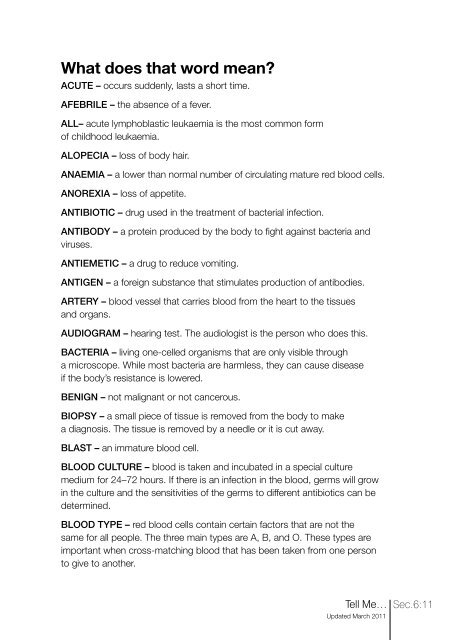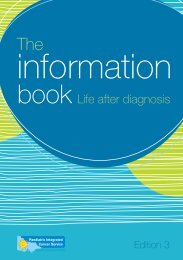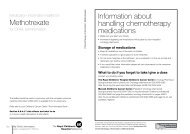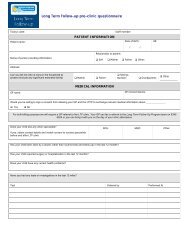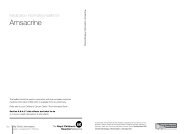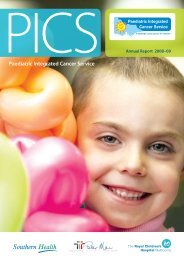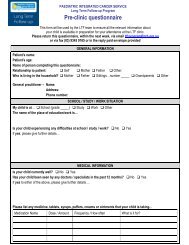- Page 1 and 2:
Coordinated and facilitated by the
- Page 3 and 4:
100129 Updated March 2011 The Infor
- Page 5 and 6:
Outpatients at the CCC (RCH) ......
- Page 7 and 8:
Hospital facilities................
- Page 9 and 10:
4 Cancer Children’s cancers & tre
- Page 11 and 12:
Parents Cancer Connect - Cancer Cou
- Page 13 and 14:
Ultrasound scan....................
- Page 15 and 16:
We are grateful to the KOALA Founda
- Page 17 and 18:
YOUR CHILD’S DIAGNOSIS: Your chil
- Page 19 and 20:
Your child’s team Many people wil
- Page 21 and 22:
The ward The Children’s Cancer Ce
- Page 23 and 24:
SCHOOL - AGE CHILDREN & ADOLESCENTS
- Page 25 and 26:
A menu monitor will collect your ch
- Page 27 and 28:
Sharing the ward The ward is a shar
- Page 29 and 30:
...and going home: what to take The
- Page 31 and 32:
Blood test Before seeing the doctor
- Page 33 and 34:
Going nuts with Macadamia “Going
- Page 35 and 36:
Sec.2.0:16 Your child’s hospital
- Page 37 and 38:
Medical Appointments CCC Outpatient
- Page 39 and 40:
The Peter Mac team The Paediatric,
- Page 41 and 42:
Radiotherapy planning Planning for
- Page 43 and 44:
Generally there are set meal times
- Page 45 and 46:
Showers & toilet facilities Showers
- Page 47 and 48:
Social Work Social Work Department
- Page 49 and 50:
The ward Monash Children’s has tw
- Page 51 and 52:
• Bring familiar items from home
- Page 53 and 54:
Parking Monash Medical Centre’s c
- Page 55 and 56:
...and going home: what to take The
- Page 57 and 58:
On arrival for your child’s appoi
- Page 59 and 60:
Sec.2.2:12 Your child’s hospital
- Page 61 and 62:
Social Work and interpreters Social
- Page 63 and 64:
Sec.2.2:16 Your child’s hospital
- Page 65 and 66:
Sec.2.3:2 Your child’s regional h
- Page 67 and 68:
Coming to hospital: what to bring..
- Page 69 and 70:
Parent meals Meals will be provided
- Page 71 and 72:
Television Please do not bring in a
- Page 73 and 74:
Quick Help If you are concerned abo
- Page 75 and 76:
Sec.2.3:12 Your child’s regional
- Page 77 and 78:
Coming to hospital: what to bring..
- Page 79 and 80:
Food can be bought in the hospital
- Page 81 and 82:
Television Please do not bring in a
- Page 83 and 84:
Quick Help If you are concerned abo
- Page 85 and 86:
Sec.2.4:10 Your child’s regional
- Page 87 and 88:
Coming to hospital: what to bring..
- Page 89 and 90:
• The Hospital Dining Room, First
- Page 91 and 92:
Visitors Parents have 24 hours acce
- Page 93 and 94:
Quick Help If you are concerned abo
- Page 95 and 96:
Sec.2.5:10 Your child’s regional
- Page 97 and 98:
Coming to hospital: what to bring..
- Page 99 and 100:
If the food on the menu does not su
- Page 101 and 102:
Associate Unit Managers (AUM) manag
- Page 103 and 104:
Quick Help If you are concerned abo
- Page 105 and 106:
Sec.2.6:10 Your child’s regional
- Page 107 and 108:
Coming to hospital: what to bring..
- Page 109 and 110:
Morning and afternoon tea is also o
- Page 111 and 112:
A Appointments Do you have a follow
- Page 113 and 114:
Sec.2.7:8 Your child’s regional h
- Page 115 and 116:
Sec.2.7:10 Your child’s regional
- Page 117 and 118:
Coming to hospital: what to bring..
- Page 119 and 120:
Pharmacy Pharmacy is located on the
- Page 121 and 122:
Hospital facilities ATM cash point
- Page 123 and 124:
Quick Help If you are concerned abo
- Page 125 and 126:
Sec.2.8:10 Your child’s regional
- Page 127 and 128:
Before the procedure • Talk with
- Page 129 and 130:
Fatigue & sleepiness Fatigue is a c
- Page 131 and 132:
DO NOT bring your child directly to
- Page 133 and 134:
Signs of Measles • Sneezing, wate
- Page 135 and 136:
Hints to increase the nutrition lev
- Page 137 and 138:
Check your child’s mouth regularl
- Page 139 and 140:
Hints to help your child take medic
- Page 141 and 142:
The health support plan should be m
- Page 143 and 144:
Professional development opportunit
- Page 145 and 146:
• When visiting households with a
- Page 147 and 148:
Helping your child cope with illnes
- Page 149 and 150: Taking care of your relationships H
- Page 151 and 152: • Some siblings benefit from canc
- Page 153 and 154: With your workmates Sometimes, cont
- Page 155 and 156: • Stay with your brother or siste
- Page 157 and 158: Before doctors decide the best way
- Page 159 and 160: The reason your Consultant Oncologi
- Page 161 and 162: Radiotherapy is a very effective tr
- Page 163 and 164: Examples of complementary & alterna
- Page 165 and 166: Low neutrophil count Neutrophils ar
- Page 167 and 168: Digestive system side effects - Mou
- Page 169 and 170: Hair & skin side effects Some treat
- Page 171 and 172: Reproductive system side effects Im
- Page 173 and 174: Nursing & medical supportive care S
- Page 175 and 176: During this time we are also prepar
- Page 177 and 178: Other assistance Ambulance transpor
- Page 179 and 180: Parent Advisory Group (CCCPAG) The
- Page 181 and 182: KOALA Foundation The Kids Oncology
- Page 183 and 184: Fundraising groups Cancer In Kids A
- Page 185 and 186: The Royal Children’s Hospital Fou
- Page 187 and 188: Seeking Information Websites, the i
- Page 189 and 190: Sec.5:14 More support Updated March
- Page 191 and 192: Associate Nurse Unit Managers Assoc
- Page 193 and 194: Neuropsychologist The Neuropsycholo
- Page 195 and 196: Patient Services Assistants (PSA) P
- Page 197 and 198: Echocardiogram An ultrasound test i
- Page 199: With the Insuflon in place your chi
- Page 203 and 204: INTRAVENOUS (IV) - method to admini
- Page 205 and 206: THROMBOCYTOPENIA - a reduction in t
- Page 207 and 208: Frequently asked questions During y
- Page 209 and 210: House cleaning Is it necessary to s
- Page 211 and 212: Sec.6:22 Tell Me… Updated March 2


